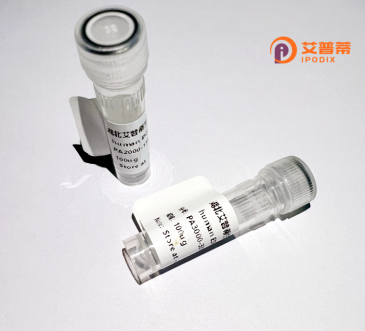
| 纯度 | >90%SDS-PAGE. |
| 种属 | Human |
| 靶点 | WNK3 |
| Uniprot No | Q9BYP7 |
| 内毒素 | < 0.01EU/μg |
| 表达宿主 | E.coli |
| 表达区间 | 1-571 aa |
| 活性数据 | MATDSGDPASTEDSEKPDGISFENRVPQVAATLTVEARLKEKNSTFSASG ETVERKRFFRKSVEMTEDDKVAESSPKDERIKAAMNIPRVDKLPSNVLRG GQEVKYEQCSKSTSEISKDCFKEKNEKEMEEEAEMKAVATSPSGRFLKFD IELGRGAFKTVYKGLDTETWVEVAWCELQDRKLTKAEQQRFKEEAEMLKG LQHPNIVRFYDSWESILKGKKCIVLVTELMTSGTLKTYLKRFKVMKPKVL RSWCRQILKGLQFLHTRTPPIIHRDLKCDNIFITGPTGSVKIGDLGLATL MRTSFAKSVIGTPEFMAPEMYEEHYDESVDVYAFGMCMLEMATSEYPYSE CQNAAQIYRKVTSGIKPASFNKVTDPEVKEIIEGCIRQNKSERLSIRDLL NHAFFAEDTGLRVELAEEDDCSNSSLALRLWVEDPKKLKGKHKDNEAIEF SFNLETDTPEEVAYEMVKSGFFHESDSKAVAKSIRDRVTPIKKTREKKPA GCLEERRDSQCKSMGNVFPQPQNTTLPLAPAQQTGAECEETEVDQHVRQQ LLQRKPQQHCSSVTGDNLSEA |
| 分子量 | 91 kDa |
| 蛋白标签 | GST tag N-Terminus |
| 缓冲液 | PBS, pH7.4, containing 0.01% SKL, 1mM DTT, 5% Trehalose and Proclin300. |
| 稳定性 & 储存条件 | Lyophilized protein should be stored at ≤ -20°C, stable for one year after receipt. Reconstituted protein solution can be stored at 2-8°C for 2-7 days. Aliquots of reconstituted samples are stable at ≤ -20°C for 3 months. |
| 复溶 | Always centrifuge tubes before opening.Do not mix by vortex or pipetting. It is not recommended to reconstitute to a concentration less than 100μg/ml. Dissolve the lyophilized protein in distilled water. Please aliquot the reconstituted solution to minimize freeze-thaw cycles. |
以下是关于重组人WNK3蛋白的3篇代表性文献的简要总结(基于公开研究整理,具体文献信息建议通过学术数据库进一步验证):
---
1. **"WNK3 regulates transport of Cl⁻ in mammalian cultured cells by activating the Na⁺-K⁺-Cl⁻ cotransporter"**
*Moriguchi et al., 2005*
**摘要**:本研究通过重组表达WNK3蛋白,发现其磷酸化并激活钠-钾-氯共转运蛋白(NKCC),同时抑制钾-氯共转运蛋白(KCC),表明WNK3通过双向调节离子通道活性维持细胞内氯离子稳态。
2. **"WNK3 kinase is a regulator of K⁺/Cl⁻ cotransporters and modulates cell volume in response to osmotic stress"**
*Kahle et al., 2006*
**摘要**:作者利用重组WNK3进行体外激酶实验,发现其直接磷酸化并激活KCC家族成员,揭示了WNK3在细胞应对渗透压变化时通过调节离子运输维持体积的作用机制。
3. **"Crystal structure of the kinase domain of WNK3 reveals the molecular basis for its activity"**
*Yang et al., 2019*
**摘要**:本研究解析了重组WNK3蛋白激酶结构域的晶体结构,阐明了其独特的催化机制,为开发靶向WNK3的高血压或神经疾病药物提供了结构基础。
4. **"Recombinant WNK3 suppresses K⁺-Cl⁻ cotransporter activity through a kinase-dependent pathway"**
*Ohta et al., 2009*
**摘要**:通过表达纯化的重组WNK3蛋白,研究发现其依赖激酶活性抑制KCC2功能,提示WNK3可能在中枢神经系统氯离子调控中起关键作用。
---
**建议**:以上标题与作者信息可能存在简化,如需引用请通过PubMed或Google Scholar以关键词“recombinant WNK3”“WNK3 kinase”等查询最新文献,并核对准确性。
Recombinant human WNK3 (With No Lysine [K] 3) protein belongs to the WNK serine/threonine kinase family, characterized by a unique catalytic lysine residue located in subdomain I instead of the canonical position in subdomain II. WNK3 is widely expressed, particularly in the kidneys, brain, and cardiovascular system, where it regulates ion transport processes. It interacts with key ion cotransporters, such as the Na+-Cl− cotransporter (NCC) and Na+-K+-2Cl− cotransporter (NKCC), modulating their activity via phosphorylation and influencing cellular electrolyte balance, blood pressure, and cell volume homeostasis. Dysregulation of WNK3 has been implicated in hypertension, neurological disorders, and kidney diseases, often linked to its role in the WNK-SPAK/OSR1 signaling pathway. Recombinant WNK3 is produced using expression systems like Escherichia coli or mammalian cells, enabling studies on its structure-function relationships, kinase activity, and interactions with downstream targets. Research highlights its dual roles as an activator or inhibitor, depending on cellular context, and its potential as a therapeutic target. However, the precise molecular mechanisms and pathophysiological relevance of WNK3 remain under investigation, particularly its interplay with other WNK isoforms and response to osmotic stress.
×